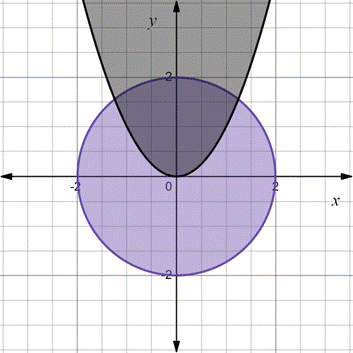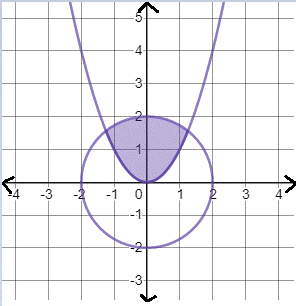
To calculate: The solution of the system of inequality by using the algebraic method and support the answer by using graph.
The common region in the graph is the solution of the inequality.
Given Information:
The system of inequality is,
Calculation:
Consider the given system of inequality,
The boundary point is included if the inequality containing
In the first inequality, the boundary is
And,
The intercepts of the equation are
To determine the half-plane to be shaded, use a test point not on the boundary, say
The statement is true so the shade the half-plane where
In the second inequality, the boundary is
Find the intercept of the circle. Substitute 0 for x and then 0 for y in the line one by one.
And,
The intercepts of the equation are
To determine the half-plane to be shaded, use a test point not on the boundary, say
The statement is true so the shade the half-plane where
Now, make the graph of the inequality.

Thus, the shaded part by both the inequality is the solution of the inequality.
Now, use the graphing calculator to draw the solution of the inequality.

Hence, the solution is verified by the graphing calculator.
Chapter 7 Solutions
PRECALCULUS:GRAPHICAL,...-NASTA ED.
 Calculus: Early TranscendentalsCalculusISBN:9781285741550Author:James StewartPublisher:Cengage Learning
Calculus: Early TranscendentalsCalculusISBN:9781285741550Author:James StewartPublisher:Cengage Learning Thomas' Calculus (14th Edition)CalculusISBN:9780134438986Author:Joel R. Hass, Christopher E. Heil, Maurice D. WeirPublisher:PEARSON
Thomas' Calculus (14th Edition)CalculusISBN:9780134438986Author:Joel R. Hass, Christopher E. Heil, Maurice D. WeirPublisher:PEARSON Calculus: Early Transcendentals (3rd Edition)CalculusISBN:9780134763644Author:William L. Briggs, Lyle Cochran, Bernard Gillett, Eric SchulzPublisher:PEARSON
Calculus: Early Transcendentals (3rd Edition)CalculusISBN:9780134763644Author:William L. Briggs, Lyle Cochran, Bernard Gillett, Eric SchulzPublisher:PEARSON Calculus: Early TranscendentalsCalculusISBN:9781319050740Author:Jon Rogawski, Colin Adams, Robert FranzosaPublisher:W. H. Freeman
Calculus: Early TranscendentalsCalculusISBN:9781319050740Author:Jon Rogawski, Colin Adams, Robert FranzosaPublisher:W. H. Freeman
 Calculus: Early Transcendental FunctionsCalculusISBN:9781337552516Author:Ron Larson, Bruce H. EdwardsPublisher:Cengage Learning
Calculus: Early Transcendental FunctionsCalculusISBN:9781337552516Author:Ron Larson, Bruce H. EdwardsPublisher:Cengage Learning





